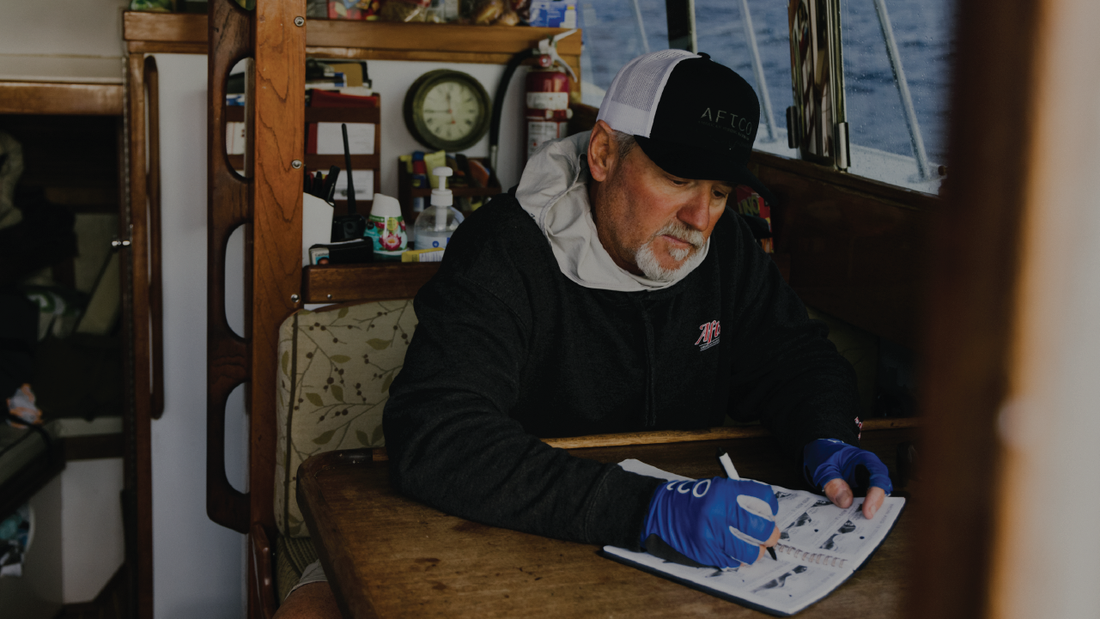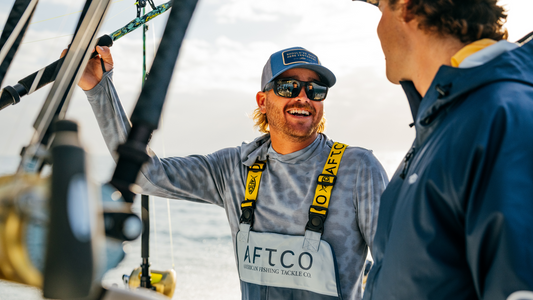
The History of Avalon Tuna Club - Behind the Story: Year of the Bluefin
“Well, it really all starts with Catalina Island,” a story told with a whisper of the past, something only Greg could manage. Greg Stotesbury is a bit of a legend around these parts. At AFTCO, that goes without saying. Seasoned, just like you’d imagine. A man who’s seen a few hard days and spent his best ones offshore somewhere in the pacific chasing sails, marlin, tuna, you name it, he’s caught it.
It’s only natural coming from a family with a passion for fishing and a competitive streak. He mentioned his dad was a commercial fisherman back in the day and could catch anything that swam. You’d be hard-pressed to believe any different if you’ve ever seen Greg on the water. His brother Michael and him were lucky enough to be raised surfing, fishing, diving for all kinds of seafood. Weekends were spent on the ocean, lakes, or rivers in California. They’re water people through and through; there’s no doubt about it.
The walls of his garage tell a similar story, rods hanging from every inch of real estate, ceilings included. Workbenches, line, tackle – organized chaos at its finest. His passion kicked into another level around ’84 when he started buying his own boats and getting into marlin tournaments. Just shy of 40 years to aggregate a collection like this. An American flag hangs side by side with one from the Tuna Club, both signaling a measure of sacrifice and a life of dedication most could never imagine.

The rustle of a rod being lifted off the rack recaptured our attention. Greg pulled a weathered and sturdy rod, getting everything in place to stretch some line, preparing for a trip of our own. The rhythmic click with each reel turn set the scene for the richness of the story he was about to tell
“Ever since I was a kid, bluefin tuna was kind of a mysterious creature in California. You know, I relate everything back to when I was a child….”
The smell of salt wafted through the air signaling the beginnings of authentic folklore. It’s not a far stretch to let your imagination wander to what it was like back then, well before Greg’s childhood. Before the bluefin disappeared for the first time when Catalina Island was utterly undeveloped. It was a different world back then, uncharted waters, an understatement at best.


Only four years after Catalina Island was founded, Charles Frederick Holder established the Avalon Tuna Club. It was 1898. Its name is derived from Holder’s historic rod and reel catch of a 183-pound bluefin tuna. The oldest fishing club in the United States, its goals were simple: to elevate sportfishing to the highest degree and protect California gamefish. And that, they did. Members over the years included U.S. presidents William McKinley, Grover Cleveland, and Theodore Roosevelt, along with dignitaries and celebrities like Ernest Hemingway, Winston Churchill, Cecil B. DeMille, Charlie Chaplin, and Bing Crosby.
It’s no wonder Catalina Island became a mecca of sorts for the sportfishing community. You can almost hear the crackle of the radio from way back when the hosts voice breaking through the static and drumming up a whole host of reasons to visit the mysteriously beautiful Catalina,
“Out in the blue pacific, 20 miles as the flying fish flies, lies Santa Catalina Island, a fisherman’s paradise abounding with swordfish and leaping tuna in fathomless waters reflecting the blue of the sky bathed in glorious sunshine. We’re going to start from the Tuna Club, the most famous fishing club in the world, whose membership includes celebrities from all over. Our boatman is waiting to take us out to the fishing grounds, and we’ll do battle with the most spectacular fighter of the Pacific. We’re anticipating the thrill of a lifetime."
Our imaginations run as Greg fades back into focus,
“When you’re a little kid, and you think of catching big fish, and on rod and reel, you’ve got all kinds of questions. How do you do this stuff? How do you land a 200 lb fish on rod and reel? I hope someday I get to do that, and gee, maybe I’ll actually get to pull on one of those big bluefin tuna...am I gonna be strong enough to land it? Is my tackle going to break?”

You can almost hear it now, the hum of childhood excitement in his voice. His past wonder fueling this present moment as he ramps up again,
“So in 2015, when this big fish showed up, and we caught the first over 100 lb fish just off the east end of Catalina, we were all ecstatic. Now we’ve got this fish that was so romanticized all through the history of sportfishing. I mean literally the beginnings of rod and reel sportfishing. That fish was now back.”
Hanging on every word, we prodded a little more, hoping he’d spin another thread, a deeper glimpse at the mystery. He caught on almost instinctively.
“When you see that big beast or that big blue eye and the teeth and that pretty kind of purplish-blue, that opalescent kinda pearl, blue color, that just fires me up.
Just the bulkiness, the size, I mean you just look at that fish and think that’s a predator that’s gonna kick ass on anything around. The speed and power and respect we have for them, when they churn the water, full-blown white, that’s unusual.”
Coming from a man who’s fought tirelessly to protect these fish, these words seem all the more critical. “On to the expedition now,” his enthusiasm packing a punch behind every word,
“We were lucky enough here three years ago to go out on a tagging mission with a woman by the name of Dr. Barbara Block out of Stanford University. Barbara Block is the world’s leading authority on bluefin tuna. She wanted us to catch her a bluefin tuna that was in that over 200 lb class so that she could determine how ready that fish was to spawn. They don’t spawn here. They spawn over across the pacific over by Taiwan. So she needed a fish that she could put an archival tag in, which is a tag that they actually sew into the belly of a fish.
We were lucky enough to catch her, the only 250 lb bluefin with which she’s done this. The fish came back exactly one year later, the tag popped up, and she located the tag off 80 miles off of Monterey, same exact time of year. These fish essentially do a big giant figure eight off the coast of California. They go up about as high as southern Oregon, northern California, and almost as low as Guadalupe Island, which is roughly 300 miles south of here. The top of that figure eight used to be down off Guadalupe Island, so we essentially never had access to those fish during that period from roughly 1935 until we caught those fish in 2015."
That’s the real mystery why everyone wants a bluefin. You never know how long they’ll be around.

As a Tuna Club Member, Greg knows this better than anyone. The very fish everyone that was a lost cause is back again. Which presented a challenge all its own. The Blue Button.
Under strict Tuna Club guidelines, the Tuna Club awards buttons for certain fish caught on regulation Linen or Dacron lines. The blue button used to be the only way a new Tuna Club associate could qualify as a full voting member. It required catching a tuna in Catalina waters, on regulation tackle, and weighing over 100lbs.
The significance of the buttons is the history they represent and the strict angling ethics and techniques developed by the Tuna Club founders. These men set the original standards for sportfishing tackle and angling.
Greg caught his blue button last year. The same season he got his 25th-year membership pin for the club. You could spend your life chasing an achievement like that, and we were hanging on every word as we asked to hear the story.
As he geared up to share, there was a slight pause, a hint of hesitance as he glanced down at his weathered hands for a brief, almost inconsequential moment. When his gaze met ours, there was a slight hint of sadness and depth in his eyes as he started to speak,
“Ah, it was a funny thing before I hooked that big bluefin…I get a little choked up sayin’ this, but my son was a navy engineer; he passed away a few years ago.”
The heaviness settled with the fond look in his eyes,
"I always thought of him; whenever I see birds, I think of my boy. I think about all this. And before I caught my big bluefin, we were sitting there drifting with our flying fish out, and this Laysan albatross was circling the boat. They’re usually pretty shy, and they go away, but this thing comes over and lands next to the boat, and I’m feeding it sardines. And every time I feed it a sardine, it gets a little closer.
Well, I had my linen line right out over the top of this albatross, and I’m thinking of my son and how much he loved to fish and all that. I fed him a sardine, and he kinda shook his head and ate the sardine, and he swam over in the water. And this is god’s truth. He got his head in my linen line. He shook his head and got the linen line off him, and he flew off. I was like, ‘Boy, well that was really weird, why was he, what’s going on there?’ And my brother yells down to me, ‘Oh, that was Zane, he came in to visit ya.’ Fifteen minutes later, the rod goes off, I hook my 130 lb bluefin, and I land my blue button bluefin tuna.”


Greg broke off many potential blue-button tunas before finally landing this one. He got an antique bamboo rod and pre-1950 Penn reel filled with 80-year-old 24-thread linen that tested right at 50lbs break strength.
The regulation bamboo rod Greg used was initially built for AFTCO founder J. C. Axelson back in the late ’40s. He found the old bamboo blank in the storage attic of the old AFTCO building in Irvine, CA, and rebuilt it using modern AFTCO SHD roller guides.
Greg’s words left a mark on us. His story is woven in with all the generations before. The very fish that ushered in sportfishing for California was gone for nearly a century.

Every bluefin angler in California is wondering when they might disappear again. A lifetime for any of us. That’s why many of us are so intent on learning more, what we can do to protect and preserve the Pacific bluefin in our waters. We want this to be something that stays with us.
They say we’re in the glory days right now. The times you tell your grandkids about the very same ones the Tuna Club was founded on.
But I’d like to think our brush with the past will last a little longer this time. And if we’re lucky enough, the year of the bluefin will be around for our grandkids to tell us about.
Dedicated to Zane Stotesbury





